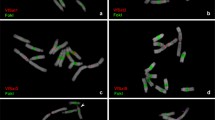Abstract
We have used a fluorescent in situ hybridization procedure to detect human satellite 1 DNA, the simple sequence family that constitutes the non-male-specific fraction of classical satellite 1 DNA. Satellite 1 appears to be located on pericentromeric regions of chromosomes 3, 4 and 13, and on satellites of each acrocentric chromosome. These results suggest a possible relationship between quinacrine fluorescence of heterochromatin and DNA composition. Furthermore, by means of multicolour in situ hybridization, we have spatially resolved satellite 1 sequences and centromeric α-satellite within heterochromatic blocks.
Similar content being viewed by others
References
Beauchamp RS, Mitchell AR, Buckland RA, Bostock CJ (1979) Specific arrangements of human satellite III DNA sequences in human chromosomes. Chromosoma 71:153–166
Choo KH, Vissel B, Nagy A, Earle E, Kalitsis P (1991) A survey of the genomic distribution of alpha satellite DNA on all the human chromosomes, and derivation of a new consensus sequence. Nucleic Acids Res 19:1179–1182
Comings DE, Avelino E, Okada TA, Wyandt HE (1973) The mechanism of C- and G-banding of chromosomes. Exp Cell Res 77:469–493
Dirks RW, Van Gijlswijk RPM, Vooijs MA, Smit AB, Bogerd J, Van Minnen JAB, Raap AK, Van der Ploeg M (1991) 3′-End fluorochromized and haptenized oligonucleotides as in situ hybridization probes for multiple, simultaneous RNA detection. Exp Cell Res 194:310–315
Franke WW, Deumling B, Zentgraf H (1973) Losses of material during cytological preparation of nuclei and chromosomes. Exp Cell Res 80:445–449
Frommer M, Prosser J, Vincent PC (1984) Human satellite I sequences include a male specific 2.47 kb tandemly repeated unit containing one Alu family member per repeat. Nucleic Acids Res 12:2887–2900
Gosden JR, Mitchell AR, Buckland RA, Clayton RP, Evans HJ (1975) The location of four human satellite DNAs on human chromosomes. Exp Cell Res 92:148–158
Gosden JR, Gosden C, Lawrie SS, Mitchell AR (1978) The fate of DNA satellites I, II, III and ribosomal DNA in a familial dicentric chromosome 13∶14. Hum Genet 41:131–141
Gosden JR, Lawrie SS, Gosden CM (1981) Satellite DNA sequences in the human acrocentric chromosomes: information from translocations and heteromorphisms. Am J Hum Genet 33:243–251
ISCN (1985) An international system for human cytogenetic nomenclature. In: Harnden DG, Path FRC, Klinger HP, Jensen JT, Kaelbling M (eds) Report of the standing committee on human cytogenetic nomenclature. Karger, Basel, pp 8–12; 48–57
Jones KW (1973) Satellite DNA. J Med Genet 10:273–281
Jones KW, Purdom IF, Prosser J, Corneo G (1974) The chromosomal localisation of human satellite DNA I. Chromosoma 49:161–171
Lindberg L, Pelto K, Borgstrom GH (1992) Familial pericentric inversion (3)(p12q24). Hum Genet 89:433–436
Mitchell AR, Beauchamp RS, Bostock CJ (1979) A study of sequence homologies in four satellite DNAs of man. J Mol Biol 135:127–149
Mitchell AR, Ambros P, McBeath S, Chandley AC (1986) Molecular hybridization to meiotic chromosomes in man reveals sequence arrangement on the no. 9 chromosome and provides clues to the nature of “parameres”. Cytogenet Cell Genet 41:89–95
Pathak S, Arrighi FE (1973) Loss of DNA following C-banding procedures. Cytogenet Cell Genet 12:414–422
Prosser J, Frommer M, Paul C, Vincent PC (1986) Sequence relationships of three human satellite DNAs. J Mol Biol 187:145–155
Raap AK, Marijnen JGJ, Vrolijk J, Van der Ploeg M (1986) Denaturation, renaturation, and loss of DNA during in situ hybridization procedures. Cytometry 7:235–242
Sambrook J, Fritsch EF, Maniatis T (1989) Molecular cloning. A laboratory manual, 2nd edn. Cold Spring Harbor Laboratory, Cold Spring Harbor, NY
Schmid M, Guttenbach M, Nanda I, Studer R, Epplen JT (1990) Organization of DYZ2 repetitive DNA on the human Y chromosome. Genomics 6:212–218
Schweizer D (1976) Reverse fluorescent chromosome banding with chromomycin and DAPI. Chromosoma 58:307–324
Smith KD, Young KE, Talbot CC, Schmeckpeper BJ (1987) Repeated DNA of the human Y chromosome. Development [Suppl] 101:77–92
Author information
Authors and Affiliations
Rights and permissions
About this article
Cite this article
Tagarro, I., Wiegant, J., Raap, A.K. et al. Assignment of human satellite 1 DNA as revealed by fluorescent in situ hybridization with oligonucleotides. Hum Genet 93, 125–128 (1994). https://doi.org/10.1007/BF00210595
Received:
Revised:
Issue Date:
DOI: https://doi.org/10.1007/BF00210595




